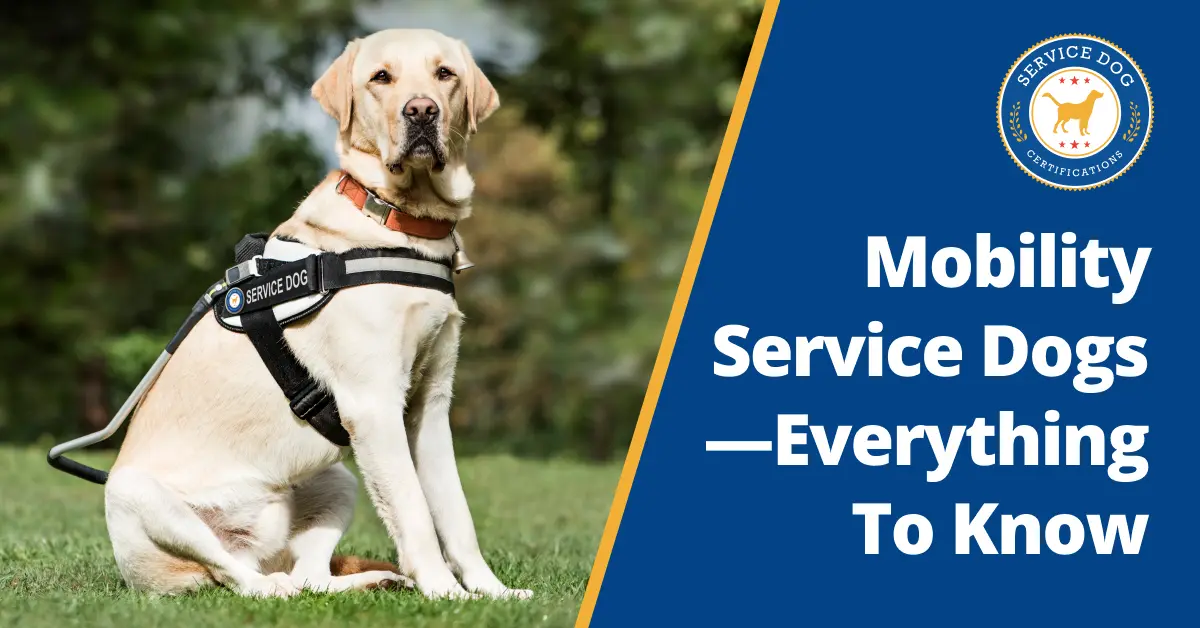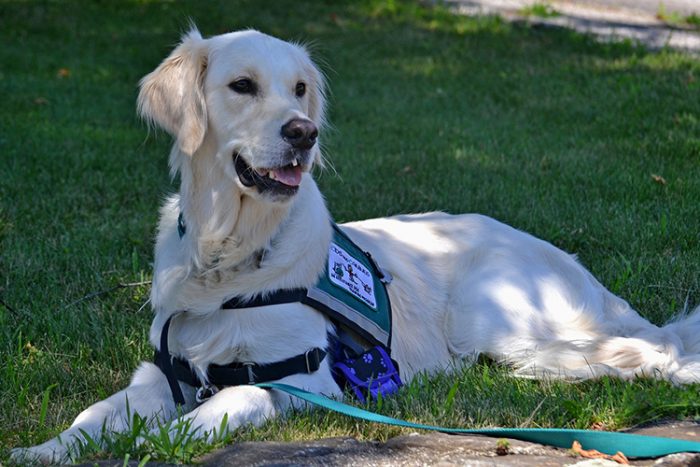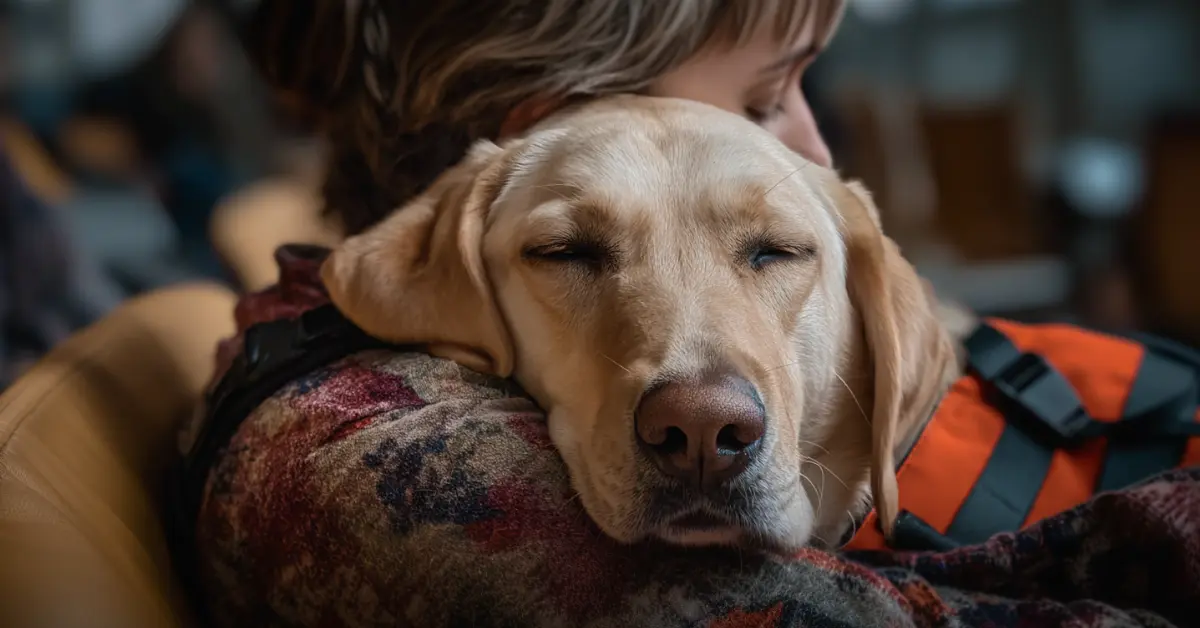Mobility Service Dogs Guide

Mobility service dogs assist individuals with physical disabilities to move more safely. They are trained to perform service dog tasks that reduce risk and effort. Typical work includes retrieving dropped items, providing steadying support, and assisting with sit-to-stand transitions. In this guide, we’ll teach you everything you need to know about mobility service dogs.
In this article:
- Disabilities that require a mobility dog
- Mobility dog tasks
- Selecting the right dog
- Mobility dog equipment
Disabilities that Require a Mobility Dog
Under ADA service dog laws, you can have a service dog if your condition substantially limits major life activities like walking, standing, bending, balancing, or lifting. Your service dog must be trained to perform tasks that directly assist with those limitations (for example, picking up items, providing light counterbalance in a mobility harness, operating doors/buttons, or helping with safe transfers). In plain terms, if mobility tasks are hard or unsafe on a regular basis, and a trained dog’s work would reduce that risk, you may qualify.
These are examples of conditions people have when they need a mobility service dog:
- Chronic knee or ankle instability after an old injury (falls risk, difficulty on stairs/curbs).
- Osteoarthritis in hips/knees making standing from chairs and walking distances hard.
- Chronic back pain with nerve involvement that limits bending/stooping and safe reach.
- Vestibular migraine or benign positional vertigo causing intermittent dizziness/balance loss.
- Peripheral neuropathy (e.g., diabetic) reducing foot sensation and steady gait.
- Dysautonomia/POTS with orthostatic intolerance (lightheadedness, unsteady starts).
- Hypermobility spectrum/Ehlers-Danlos causing joint subluxations and frequent instability.
- Post-viral or long-COVID fatigue/weakness that limits standing, walking, and carrying.
Mobility Dog Tasks
A mobility service dog helps you move through daily life more safely and with less effort, whether you walk, use a cane, or use a wheelchair. The dog works close to your side (or chair), keeps a steady line, and gives light, controlled support when you start, stop, turn, or navigate curbs and thresholds. Think of the dog as a living handrail and helpful reacher that is steady during stand-ups or transfers, and able to bring things to your hand or lap so you don’t have to bend or overextend.
From a seated position, the same skills make everyday tasks easier. The dog can pick up what you drop, press door and elevator buttons, open doors with a pull strap, and deliver items to another person. Keep in mind that any bracing, counterbalance, or transfer work should utilize proper equipment and receive guidance from a vet or physio.
Here are some examples of mobility dog tasks:
- Help you stand up or sit down by holding a steady position next to you (with a proper harness).
- Give light counterbalance so you don’t tip during turns, curbs, or uneven ground.
- Keep a straight walking line and pause at edges, stairs, or doorways.
- Offer balance help on stairs — slow, step-by-step, stopping when you stop.
- Create a little “bubble” in crowds by standing in front/alongside so you have space.
- Hold steady during a safe transfer (chair ↔ seat/bed/toilet) so you don’t wobble.
- Short, controlled tugs to help a manual wheelchair over a threshold or small ramp.
- Start gentle forward momentum to get rolling or walking, then release on cue.
- Pick up dropped items and place them in your hand or on your lap.
- Bring specific things on cue (phone, cane, wallet, water bottle).
- Carry small items in a pouch and deliver them to you or another person.
- Open doors with a pull strap; close doors, drawers, and cabinets a few inches.
- Press automatic door plates and elevator buttons.
- Turn lights on or off with nose or paw.
- Help in a public restroom (open/close stall door, hand you tissues, steady stand for transfers).
- Remove light clothing items (gloves, hat, socks; help slide a sleeve).
- Tug a zipper or pull tab to start a jacket or bag opening.
- Place items on a counter, shelf, or into a bin; gather scattered items into one spot.
- Find and lead you to simple targets (bench, exit, elevator, your car).
- “Stand and stop” if you stumble or your chair bumps, so you can regain balance.
- Wait calmly beside you as an anchor point while you rest or recover from dizziness.
- Bring another person for help on cue (e.g., “find help”).
If you’re thinking about training a dog to perform these tasks, check out our service dog training guide.
Selecting the Right Dog
When finding a mobility service dog, first consider what you need help with on a day-to-day basis. Think about simple moments like standing up from a chair, keeping steady on curbs, picking up dropped keys, and walking through a busy store. Write those down in plain language. That list is your “job description” for the dog.
Next, match the dog’s body and temperament to the job. For most mobility work, you want a calm, people-focused adult dog with a sturdy build and smooth, easy movement. Common choices are Labrador Retrievers and Golden Retrievers because they’re steady, social, and strong; many beginners do well with them. If you need a lower-shedding option with a similar size and smarts, a Standard Poodle can be a great fit. For lighter tasks like retrieving and light balance support, a well-built Lab or Golden mix can also work. A simple rule of thumb is that the dog should be tall and solid enough for your height and stride, and should pass basic health checks for hips, elbows, and shoulders.
To get more ideas on what dog might best suit your needs, check out our list of the best breeds for mobility service dogs.

Mobility Dog Equipment
The main tool for mobility service dog handlers is a mobility harness with a firm handle that matches your height. It should fit snugly, but allow your dog to move easily. Use a 4–6 foot leash, or a hands-free leash that clips to your belt. If you use a wheelchair, a short leash tab or a clip point on the chair keeps the leash tidy. For outdoor adventures, add a door-pull strap, a dog seat belt that’s crash-tested for the car, and booties for slick floors or hot pavement. A ramp or step can help the dog get into the car, and a non-slip mat helps on shiny floors during stand-ups or transfers.
The ADA doesn’t require special vests or papers, but most handlers use service dog signalers, such as vests, ID cards, and tags, so that people are aware their dogs are at work.
About the Author: The writing team at Service Dog Certifications is made up of folks who really know their stuff when it comes to disability laws and assistance animals. Many of our writers and editors have service dogs themselves and share insights from their own experiences. All of us have a passion for disability rights and animals.
Related Articles

How Dogs Can Calm Anxiety
A person suffering from anxiety attacks experience many risks, and it’s one of the reasons why it’s prudent to consider having a service dog or emotional support animal as a companion. The animal can keep the environment safer for the individual and below are some of the ways a dogs can calm anxiety: 1) Dogs […]

Read More

How Dogs Stop Panic Attacks
When a panic attack hits, your heart races, chest tightens, and thoughts scramble, leaving you in a vulnerable state. Debilitating panic attacks can qualify as an ADA disability, and a psychiatric service dog can be trained to stop a panic attack by doing the following: • Performing deep pressure therapy that switches your nervous system […]

Read More

Service Dogs for PTSD
Service dogs for mental health, known as psychiatric service dogs (PSD), can help certain people with post-traumatic stress disorder (PTSD). A PTSD service dog can legally accompany their handler in areas open to the public, residential buildings that ban pets, and on airplanes. In this article, we will explain how a service dog can assist […]

Read More

Hello, I have been having vertigo and vestibular migraines for about 7 years now. We recently have rescued a 10 week old Bernie’s mountain dog mix puppy from the shelter. He has a great demeanor and my spouse and I are hoping that we can get help training him to help me with my mobility issues whenever I am experiencing vertigo spells or extended on and off dizzy spells. Things like helping me make my way up and down stairs, navigating to the bathroom, or even helping me get from my classroom to the outside parking lot when an emergency happens. Do you believe this is something we can try to do with our new Pup and do you know of services, classes, or other offerings that could help us train, or give advice on this?
Thank you for taking the time to get back to us.
Unfortunately we don’t provide referrals for training, but we recommend speaking to both your healthcare provider and an experienced service dog trainer. If and when you do qualify as a service dog owner we would love to help you.
It you will need to use him for any wt. bearing, have a vet check him for any issues with hip displasia FIRST
Hi. I’m in NW Indiana, close to Chicago. I am on SSDI for a visual disability. I lost my left eye and have a condition called Charles Bonnet Syndrome. The easiest way to explain it is that it’s the eye version of phantom limb, but instead of feeling an eye that isn’t there, I hallucinate constantly. My brain never recognized the eye loss, so I basically always have distorted vision. Most of the times it’s shapes and colors overlaying my vision, but I do also occasionally see fully formed things. While I know they aren’t real, they can startle me and make me jump away. Because of this, I have severe balance issues and no depth perception at all. I’d like to know how I go about starting the process of getting a mobility support dog. The larger the breed, the better. I need a dog big enough that if I start to fall, I won’t hurt it using it to help, and large enough I can use it to help me get out of the bath tub safely, and things like that. I also need help walking outside my own street, as often I’ll see holes in the ground that aren’t there, and if a dog could lead me, I wouldn’t jump away from things that aren’t really there, as my body reacts before my brain connects that what I’m see isn’t there. Because I’m on SSDI for this, I’m confident my neurologist or GP would be on board. I just have no idea where on earth to start. I don’t think I need a seeing eye dog, as I always have a general idea of where I’m going, but I do need help preventing falls and navigating aisles at stores, narrow ways, ground that isn’t completely flat, etc… Outside of a large breed, being cat friendly is a must. Does anyone know how and where I get started with this process?